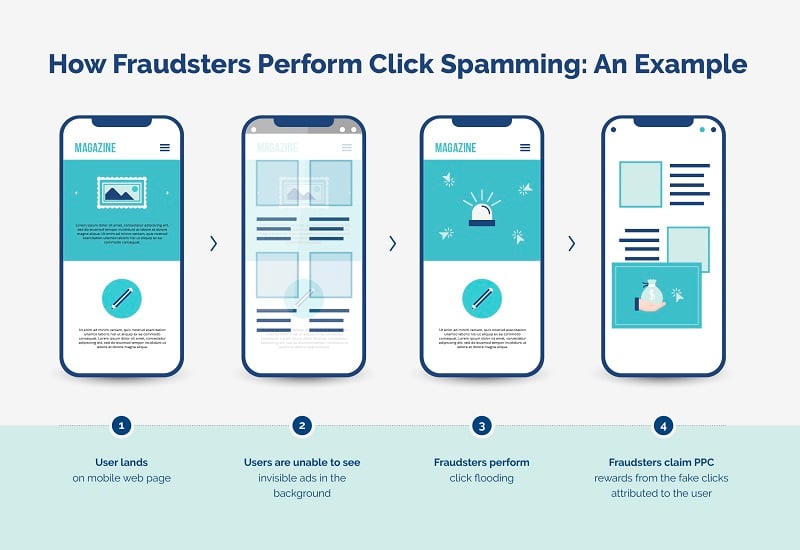What is Click Spamming and How to Prevent it

According to a study conducted by Hewlett Packard, ad fraud is not only the most lucrative form of cybercrime but also one of the easiest for fraudsters to carry out, too.
Certain types of ad fraud target cost-per-mille (CPM) campaigns, cost-per-click (CPC), and cost-per-lead (CPL) campaigns. Fraudsters also use many ad fraud techniques to focus their efforts on both pay-per-click (PPC) and cost-per-install (CPI) campaigns.
One such technique is click spamming fraud, which is used by bad actors to drain advertising budgets and perform install attribution fraud.
Here, we’ll explore how click spamming fraud works, the damage it can cause your organization, and the anti-fraud solutions required to prevent it.
How does click spamming work?
Click spamming fraud happens when fraudsters execute clicks for real users who haven’t made them. To do this, they perform click flooding, whereby they send a large amount of low-quality fake clicks to an ad in an attempt to claim credit from PPC budgets or obtain attribution before an action, such as an app installation.
The click spamming cycle starts when a user lands on a mobile web page or in an app where a fraudster is already operating. Once this happens, fraudsters can perform several types of fraud:
- While the real user engages with an app, fraudsters execute fake clicks in the background, which makes it appear as if the interactions have been instigated by the user.
- The mobile web page could be sending clicks to invisible ads in the background.
- Fraudsters can send clicks from users’ devices to random vendors, where they can then collect the payment for ads.
- If the user is running an app that is active in the background, such as a battery saver, the fraudulent app can continue to generate clicks.
The main thing to note about all of these methods is that the real user is unaware of the fact that these fraudulent activities have been attributed to them. This is because both the ad and the click spamming are invisible to the user.

What are the threats posed by click spamming?
When click spamming is not detected and prevented, fraudsters receive payouts for fake clicks since the clicks will be attributed to supposed real users. This has many effects on advertisers. Below, we go through some of the main threats and consequences of click spamming fraud.
Wasted ad spend
Since click spamming leads to fake ad engagements, organizations lose money that could have been spent on reaching real users.
Misguided strategies
When organizations are unaware that click spamming has taken place, they take the data from the falsely attributed organic users into account when deciding on future strategies and campaigns.
For example, if they advertise via a channel that is subject to click spamming fraud, the number of fake engagements can make this channel appear to be more lucrative than others. Organizations may then decide to invest more money in this channel, but receive fewer valuable conversions than they believe.
Since other more genuinely valuable channels don’t appear to perform as well, organizations are also losing out on investing their budget in channels that have not become victims of ad fraud.
Real conversion theft
Although the click spamming engagements with the ads are fake, fraudsters receive the ad payout. This is essentially theft of real conversions.
What can you do to prevent click spamming?
Click spamming can completely and rapidly obliterate ad campaigns. There are patterns visible in data that can indicate that click spamming has occurred. For example, if there are a large number of distributed clicks in a short amount of time that quickly taper off, it’s likely that click spamming is behind them.
Although it can feel as though ad fraud is inevitable, click spamming doesn’t have to be part of the advertising life cycle. Anti-fraud solutions are the most effective way of proactively and continuously protecting your organization against click spamming fraud since they can...
Clicks from click spamming are generated using automated processes or exist in the background and are not visible to users. Anti-fraud solution Opticks can detect such automated processes and odd patterns, and flag the fraudulent clicks.
Protect your budget and campaigns from click spamming fraud
Click spamming is an easy method of ad fraud to carry out. That makes it all the more frustrating when they’re able to drain your budgets and skew your campaign data.
Luckily, anti-fraud solutions are designed solely to prevent fraudsters from eating into your ad spend, and help you focus on the success of your next campaign. Anti-fraud solution Opticks can prevent click spamming and help you focus on real users and real ad engagements.
Find out more about how the expert team at Opticks can help protect your advertising campaigns, by booking a free demo.
